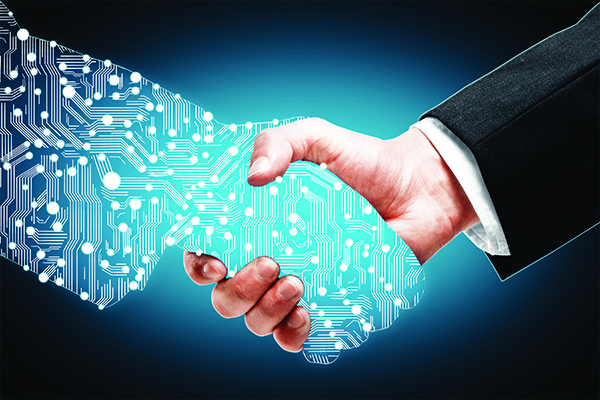The COVID -19 pandemic forced companies to advance in six months teleworking methods that would not be implemented in five years.
While this was necessary, it has all the characteristics of firefighting.
It is both successful and messy.
The measures taken to ensure the survival of business are not the same as those which will make it prosperous.
Teleworking is promising.
Employees are a happy saving commuting time of about an hour per day and Companies are happily reducing their space expenditure.
It is not all that simple.
For a business to succeed in Teleworking Environment four (4) parameters are necessary:
- People
- Methods & Procedures
- Software
- Hardware
The understanding of all the above must be reconsidered.
1. People
The first issue to recognize is that Companies that are based on technology are now more profitable than companies based on the number of employees.
Knowledge and output per employee capita are more important than total company knowledge and output. The quality of employees is much more important than their number.
As Bloomberg reports, firms that rely least on their employees have beaten more labor-intensive ones by 37 percentage points in 2020, according to an analysis by Deluard.
It is simplistic to assume that employees will be doing at home just what they were doing in the office.
A redefinition of job descriptions, duties, and methods is necessary.
A lot of tasks must be re-examined with a view to automating them.
Employees’ performance is shifting towards the quality of output rather than quantity of work.
The big issue with the front office employees is how they interact with customers.
The first thing to understand is how customers react to this new teleworking reality.
There two distinct cases:
- Α. Interacting with customers physically
- Β. Interacting with customers digitally.
Α. Interacting with customers physically is the most difficult case to adapt.

Interacting with a customer physically provides such a wealth of details and nuances that cannot be obtained through a teleconnection. The customer welcomes physical interaction in most cases and limiting it to the productive part is an important technique.
A new communication code must be established for teleconnections and a modicum of physical contact should be maintained because this both facilitates the understanding of the change in communication method so as to improve gaps and misunderstandings and also helps in humanizing the transaction.
The claim that telecommunication speeds up the transactions should be evaluated together with the indirect bonding that it is created through human contact.
Β. Interacting with customers digitally is easy for some types of business.
 The difficult part is when a complex deal must be structured.
The difficult part is when a complex deal must be structured.
In this case, more emphasis should be given to written communications with few teleconference meetings to clarify issues but most of the communication must be a written one.
The second issue is the need for a code of conduct for teleworking employees.
A properly equipped workspace at home or wherever else an employee chooses to work is mandatory.
A minimum dress guideline is very desirable.
While there is more flexibility, it has to be understood that one cannot cook in the wok and do excel at the same time.
The teleworkers must be trained to the new job discipline parameters for productivity to be optimized.
The third, equally important issue is how employees interact between themselves and how they are productively managed.
Man is a social animal and interaction between its members is absolutely necessary for any society to function.
Business society is composed of customers, employees, regulators, and social stakeholders.
All of them should be facilitated to communicate and interact in the new, remote working environment.
It is more difficult than it appears and methods and procedures for this must be designed and implemented, including some form of physical contact so as to address the need for the human experience of the workplace.
The big managerial question is how a Manager can manage his/her teleworking employees.
There are two extremes.
The low-end one is to keep track of their activities through an anti-procrastination recording device such as eyeglasses linked with AI algorithms and the web.
This allows monitoring activities including reading, writing, looking at the phone, laptop, watching TV, working out at the gym, doing yoga, cooking, playing an instrument, eating, etc.
Whether this is acceptable practice is subject to regulation and refinement.
The high-end of Managing is treating every teleworker as a freelancer, by assigning tasks and measure the quality of output and time to completion, it is important to keep time and space for human contact.
Each Company and management team has to redo find its own methods of Telemanagement.
The human contact should not be neglected.
As a rule of thumb: Teams should meet once a week average and managers must have also once a week’s physical presence with their employees.
2. Methods & Procedures.
This is a critical issue.
 A new working ecosystem must be designed and implemented.
A new working ecosystem must be designed and implemented.
The first thing to watch out for is that methods and procedures which were hastily and ad hoc adopted during the pandemic, the risk to become permanent standard practice without critical evaluation and a thoughtful outline of standards to be observed and info to be submitted.
A radical redesign of the Business Model is needed, which will start after about six months of study and take identifiable shape within a year.
The Business Model must address the correct combination of digital technology and cybersecurity, produce new managerial methods with an emphasis on communication and productivity measurements, new managerial techniques, and new HR approaches. A new timetable for most activities must be optimized so as to ensure proper Company functionality.
It will be far from perfect a year from the start, but it will be a good rough sketch of the model on which more deliberate continuous improvements can be made.
3. Software.
It is underlined that in the new digital reality, the software of the Company is not part of  the Company, the software is the Company.
the Company, the software is the Company.
This period gives a unique opportunity to radically revise all the software used and start again with a totally integrated software, suitable for teleworking and by the same opportunity demolish internal silos and make communication, cross-fertilization, data, and info available and easily retrieved throughout the Company’s activities.
It is necessary more than before for the Business to have its own executives that understand the shape and manage the software rather than depending strongly on an external provider only.
4. Hardware
Teleworking is a permanent method of employment that cannot really work with just the PC or laptop of the employee.
Two Levels:
- Remote Employee Level
- Company Level
A homogeneity of hardware is a requirement for both levels.
At the Remote Employee Level, we have 3 sub-levels:
 Ι. Secretary – Customer Service Level.
Ι. Secretary – Customer Service Level.
Multimedia of new generation (not older than 2 years) hardware with 2 screens capable of video conference and a scanner.
ΙΙ. Departments (Sales, Marketing, etc.) Level.
Here also the need for a new generation Multimedia desktop/laptop hardware capable of good quality video conferences. Second screen depending on the nature of work.
ΙΙΙ. IT Department Level.
The needs of the IT Department employees vary (depending on the type of business of the company). In general, they have the most advanced systems and definitely remote access to the main server of the company.
At the Company Level, we have 2 divisions.
 I. Company Server-Mainframe Division.
I. Company Server-Mainframe Division.
The main server of the company that has online & offline local backup hardware. Reliable Cloud connections, also are required together with a well thought out disaster recovery site that also has Cloud backup as well.
II. Front End Users Division.
New type multimedia, hi-tech conference rooms, with big screens (more than 70”). The rooms also must be ready/capable of normal or VR or AR for current or future meetings. New advanced mobile phones and/or tablets (depending on the type of business of the company) with a big screen.
From Retail shopping to Fossil fuels, there is a radical change and reappraisal of what produces Value.

